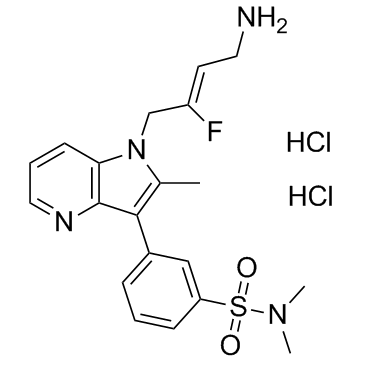| Description |
PXS-5153A is a potent, selective, orally active and fast-acting inhibitor of lysyl oxidase like 2/3 enzymatic (LOXL2/LOXL3), with an IC50 of <40 nM for LOXL2 across all mammalian species and an IC50 of 63 nM for human LOXL3. PXS-5153A could reduce crosslinks and ameliorates fibrosis.
|
| Related Catalog |
|
| Target |
IC50: <40 nM (LOXL2 across all mammalian species), 63 nM (human LOXL3)[1].
|
| In Vitro |
PXS-5153A exhibits an IC50 of <40 nM for LOXL2 across all mammalian species tested. PXS-5153A also inhibits human LOXL3 with an IC50 value of 63 nM. PXS-5153A is >40-fold selective for LOXL2 over both LOX and LOXL1 and >700-fold selective over other related amine oxidases. PXS-5153A is a fast acting inhibitor, with enzymatic activity almost entirely blocked within 15 minutes [1].
|
| In Vivo |
As expected, rhLOXL2 dose-dependently induce oxidation of collagen with PXS-5153A dose-dependently impeding collagen oxidation. Therapeutic treatment of PXS-5153A substantially reduces immature crosslink formation compared with the CCl4 treated animals. Mature crosslink formation is also reduced by PXS-5153A treatment. All groups with therapeutic treatment of PXS-5153A show a significant reduction in DHLNL formation compared to the CCl4 treated animals. Treatment with PXS-5153A causes a significantly reduction in HYP compared to the CCl4 group. In addition, the amount of fibrillar collagen is markedly augmented by disease as seen by the 2.2-fold increase in percentage coverage area by Picrosirius red staining, which is reduced by PXS-5153A[1].
|
| Animal Admin |
Rats[1] Sprague Dawley rats are orally administered with 0.25 μL/g Carbon tetrachloride (CCl4) in olive oil solution, starting from day 0, 3 times per week for 6 weeks. PXS-5153A is given by oral gavage after 3 weeks of CCl4 administration and continued throughout the remainder of the study at 3 mg/kg (low dose) or 10 mg/kg (high dose) once a day or 10 mg/kg (high dose) three times a week. Alanine aminotransferase (ALT) and aspartate aminotransferase (AST) levels were assessed in the plasma. Mice NASH is established in male C57/BL6 mice by a single subcutaneous injection of 200 μg streptozotocin after birth and with a high fat diet ad libitum after 4 weeks of age (day 28 ± 2) until 14 weeks of age. Mice are orally administered with 10 mg/kg PXS-5153A once daily from 8 to 14 weeks of age. ALT levels are assessed in the plasma. Mice Myocardial infarction (MI) is induced in C57/BL6 mice by occluding the left coronary artery. At 24 hours post-surgery, animals receive echocardiography. Infarcted mice with high cardiac function (FS > 40%) or low cardiac function (FS<10%) are excluded from the study. The remaining mice are treated q.d., p.o., with 25 mg/kg of PXS-5153A for 4 weeks. At the end of the experiment, echocardiography is performed on mice to assess left ventricular function and remodelling, followed by heart collection. The heart is fixed with 10% formalin. Fibrosis is assessed in the non-infarct area[1].
|
| References |
[1]. Schilter H, et al. The lysyl oxidase like 2/3 enzymatic inhibitor, PXS-5153A, reduces crosslinks and ameliorates fibrosis. J Cell Mol Med. 2018 Dec 9.
|
